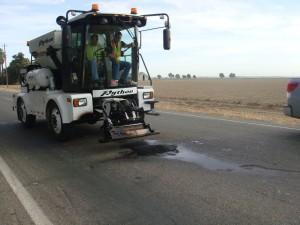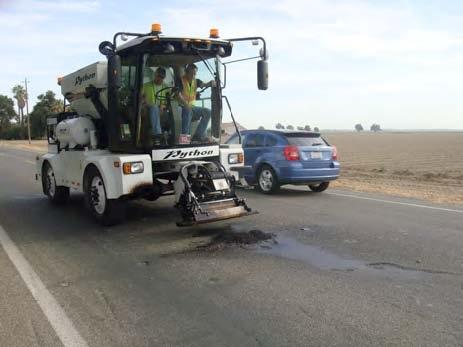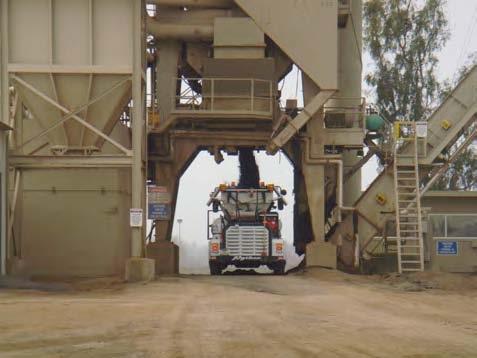
Python - Automated Hot Asphalt Pothole Repair
Link to pdf here.
Python PHP deployment in Caltrans District 4 at San Jose on 03/12/2013 and 03/13/2013. (High Resolution 128 MB)
Python PHP deployment in Caltrans District 4 at San Jose on 03/12/2013 and 03/13/2013. (Low Resolution)
Python PHP training video
Python PHP deployment in Caltrans District 4 on HWY 280 on August 9th
Two Caltrans workers have been killed recently while attempting to patch highway potholes. In an immediate response to mitigate this hazard, Caltrans Divisions of Research and Maintenance are supporting an AHMCT research effort to deploy innovative equipment to Caltrans Maintenance crews to dramatically reduce worker exposure when conducting highway patching operations.
Pothole Filling Operations

Highway potholes typically emerge sporadically on the highways and rarely occur in concentrated areas. Their characteristic disbursement makes the scheduling of traffic lane closures to make urgent patches very impractical. Often maintenance crews merely rely on traffic breaks, with or without CHP assistance depending on traffic flow, to make quick repairs. Frequently a maintenance worker will quickly approach a pothole on the travelway during a brief traffic break. Then cast a lump of cold patch asphalt into the void and retreat after thumping it a couple of times with a shovel or boot. Having workers on foot exposed to traffic in or adjacent to traffic is always potentially hazardous, but the nature of pothole patching operations makes this task even more risky.
Automated Pothole Patching

The greatest safety potential gain is achieved by completely removing the workers from any direct traffic exposure on the highway. This can be accomplished by making use of automated patching equipment. Selfcontained machines designed to patch potholes that can be remotely operated from inside the vehicle cab. Such equipment has been on the market for several years and has achieved nationwide service on a modest scale. This type of machine typically dispenses either hot asphalt or an emulsion based spray patch. While both process have benefits, the hot asphalt process is the most traditional and draws nearly universal support. Also, the target use of this equipment is main line highways and secondary highway with high speed traffic which favors the hot patch approach as well.
Python Patching Machine

The Python Pothole Patcher (PHP) was selected as the commercially available machine that best matches Caltrans requirements. It automates the traditional hot asphalt patch process: 1) air jet blast pothole clean, 2) tack oil spray, 3) hot asphalt fill, 4) compaction roller of patch. The quality of the resulting patch can range for long term to permanent, depending primarily on pothole cleaning. The goal is to conduct the majority of pothole patching operations free from the need of establishing fixed lane closures in order to maximize the benefit of the automated machine. The patch can be applied very quickly when needing to fit in with a moving closure operation or a very high quality patch is possible when more time is available. The machine can be easily configured for different types of patching requirements and is simple to clean.
PHP Training and Operations

Operator training for the PHP is a combination of classroom instruction and equipment operation training. Maintenance Equipment Training Academy and AHMCT are collaborating on the initial PHP program. AHMCT is further developing the machine operation training procedure to match the specific use characteristics of the PHP on the highway. It is recommended that dedicated operators are designated for each District. If practice potholes are not available at the District, a wide variety of practice templates are available for use.
Python Features and Specifications
Python Mfg. has been building PHP machines for many years and the patching capabilities of this design has been well established. The Caltrans version PHP should nevertheless be considered a prototype in a number of respects due to the many innovative machine features. An auxiliary hopper heating system was specifically developed for this version and custom designed to enable Caltrans crews to extend the time asphalt can remain in the hopper without dumping. A citrus solvent cleaning system was developed to eliminate the use of diesel solvent.
Caltrans Version PHP Specifications
- 5 Ton (10,000lb) Asphalt hopper capacity
- 35 gallon heated tack oil tank
- 20 cfm air compressor with dual 17 cu. ft air tanks
- Heated asphalt hopper
- EPA 2007 and CARB 2007 certified Cummins 6.7 L diesel engine
- Hydrostatic drive geared to travel at highway speeds (55mph)
Current Status
The Python pothole patching machine is progressing through initial deployment testing operations in D3. Looking to identify additional Caltrans deployment locations.
For Additional Information
| Arvern Lofton Caltrans Project Manager | Arvern_Lofton (at) dot.ca.gov | (916) 227-5834 |
| Steve Velinsky Principal Investigator | savelinsky (at) ucdavis.edu | (530) 752-4166 |
| Victor Reveles Primary Contact | vreveles (at) ucdavis.edu | (530) 752-3965 |
This document is disseminated in the interest of information exchange. The contents do not necessarily reflect the official views or policies of the AHMCT Research Center, the University of California, the State of California, or the Federal Highway Administration. This document does not constitute a standard, specification, regulation, or imply endorsement of the conclusions or recommendations.
